When swapping oils in soap recipes, you'll need to maintain the total oil weight while recalculating lye amounts based on each oil's saponification value. Aim for 30-40% hard oils (like coconut) and 60-70% soft oils (like olive) for balanced bars. Use a soap calculator to adjust lye quantities precisely, as each oil requires different amounts for proper saponification. Don't forget to reflect on how substitutions affect cleansing power, conditioning properties, and lather quality in your final product.
Oil Swap Calculator: Perfect Ratios for Handmade Bars
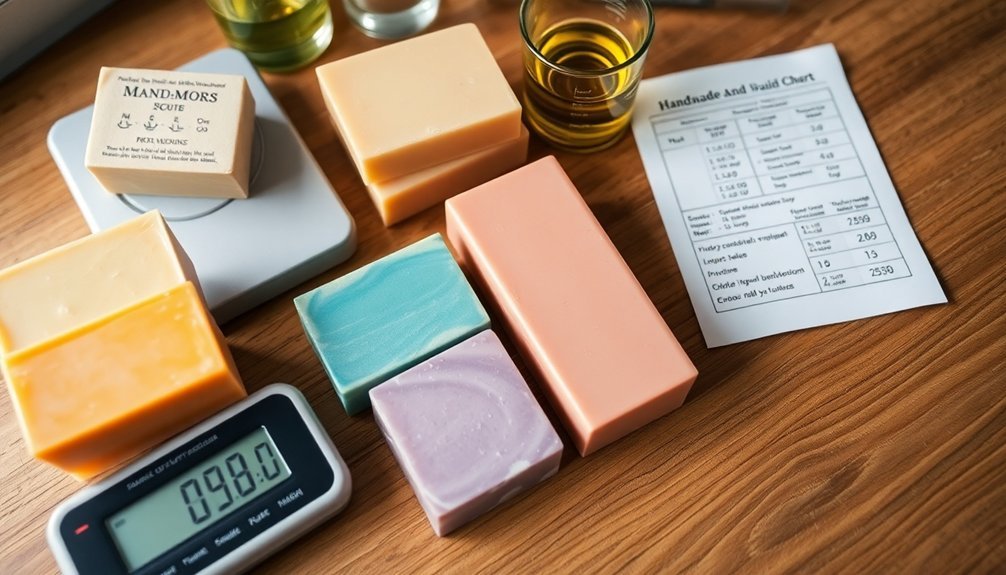
When crafting handmade soap bars, you'll occasionally need to substitute one oil for another due to allergies, availability, or cost considerations. That's where an oil swap calculator becomes indispensable to your soap making process.
Each oils and fats in your soap recipes has a unique saponification value, determining exactly how much lye is needed for proper conversion. The lye calculator automatically recalculates these values when you make substitutions, ensuring your bars maintain the proper chemical balance.
Remember to keep your total oil weight consistent with the original formula when swapping ingredients. This preserves the intended properties of your soap while allowing for flexibility in your formulation.
Whether you're working with solid or liquid oils, the calculator handles all adjustments needed for successful batches.
Understanding Soap Oil Properties and Their Impact
When swapping oils in your soap recipe, you'll need to balance hardness with conditioning properties based on each oil's fatty acid profile.
The cleansing power varies widely across different oils, with coconut providing strong cleansing abilities while olive offers gentler effects.
You'll achieve the best lather quality by combining oils that contribute both large, stable bubbles and creamy, moisturizing foam rather than relying on a single oil type.
Hardness vs. Conditioning Balance
Creating the perfect handmade soap requires balancing two essential qualities: hardness and conditioning. You'll need to carefully select oils that contribute to both properties for an ideal bar. Oils high in saturated fats, like coconut and palm, increase hardness, while unsaturated oils such as olive and almond enhance conditioning properties.
For a well-balanced bar, aim for 30-40% hard oils combined with 60-70% conditioning oils. This ratio guarantees your soap remains firm enough to last while still providing moisturizing benefits for the skin.
Remember that each oil's saponification value determines how much lye you'll need, directly affecting your final product's characteristics.
Don't hesitate to experiment with different oil ratios. By adjusting the proportions of hard and conditioning oils, you can customize your soap for specific purposes or preferences.
Cleansing Power Spectrum
Since all oils aren't created equal, understanding the cleansing power spectrum is essential for crafting your perfect bar. Oils high in saturated fats like coconut and palm deliver stronger cleansing power, creating firmer bars that effectively remove dirt and oils from skin.
Your oil swap calculator can help balance these hard oils with gentler counterparts. For instance, coconut oil boasts a cleansing value around 20, while olive oil sits near 0, offering conditioning properties instead.
The ideal soap typically contains 30-40% hard oils balanced with 60-70% soft oils.
When substituting oils, pay close attention to their saponification values—these determine the lye requirements for proper conversion. Mastering this spectrum allows you to customize your formula, creating bars that clean effectively without stripping your skin's natural moisture.
Lather Quality Factors
Beyond cleansing power, the character of your soap's lather tells a compelling story about its oil composition.
When you're formulating your recipe, understanding how each oil contributes to lather quality becomes essential for creating your ideal bar.
- Fatty acid profiles determine lather type – coconut oil creates bubbly, abundant foam while olive oil produces a creamier, more subtle lather.
- Lauric acid content directly impacts lather abundance – oils rich in this fatty acid (like coconut) generate more bubbles.
- Balancing hard and soft oils achieves the perfect lather – combine coconut's bubbles with olive oil's moisturizing properties.
- Superfatting percentage affects lather indirectly – leaving extra oils unsaponified enhances moisturizing properties while preventing the skin dryness that can inhibit good lather.
Your oil choices create a signature lather experience unique to your handcrafted soap.
The Science Behind Oil Substitution Ratios
When you're substituting oils in your soap recipe, you'll need to take into account the fatty acid profiles of each oil to maintain the desired properties in your final bar.
Your substitutions should aim to balance similar percentages of oleic, lauric, and other fatty acids that contribute to qualities like hardness, cleansing power, and moisturizing ability.
Using a soap calculator to analyze these ratios helps you predict how your modified recipe will perform and guarantees your swapped oils create a bar with properties comparable to your original formula.
Fatty Acid Profiles
The chemical makeup of oils forms the foundation of successful soap substitutions. When swapping oils, you're actually exchanging specific fatty acid profiles that determine your soap's qualities. Understanding these profiles helps you maintain your desired bar characteristics while adjusting lye calculations accordingly.
Each oil contributes differently to your finished soap:
- Saturated fats (like those in coconut oil) create harder bars with abundant lather.
- Monounsaturated fats (prevalent in olive oil) offer conditioning properties.
- Polyunsaturated fats (found in sunflower oil) contribute softness and moisturizing qualities.
- Specialty fatty acids (like lauric acid in coconut oil) provide unique benefits like cleansing power.
When making oil substitutions, the saponification value of your replacement oil determines how much you'll need to adjust your lye amount to achieve proper saponification.
Soap Property Balance
Understanding fatty acid profiles is just the beginning of crafting well-balanced soap. When you substitute oils, you must consider how each ingredient affects your final product's characteristics while maintaining proper saponification value.
| Oil Type | Property Contribution |
|---|---|
| Coconut | Creates bubbly lather, adds hardness |
| Olive | Moisturizing, creates creamy lather |
| Palm | Contributes hardness, stable lather |
| Sunflower | Light feel, conditions skin |
When swapping oils, keep the total weight consistent while adjusting the lye amount according to each oil's saponification value. A 5% superfatting rate provides a safety margin that accommodates variability in lye absorption, ensuring your soap remains skin-friendly.
The properties of specific oils dictate your formula's balance—coconut oil's cleansing power versus olive oil's gentleness. This balance determines whether your bar will be hard or soft, cleansing or moisturizing.
Essential Tools for Accurate Oil Swapping
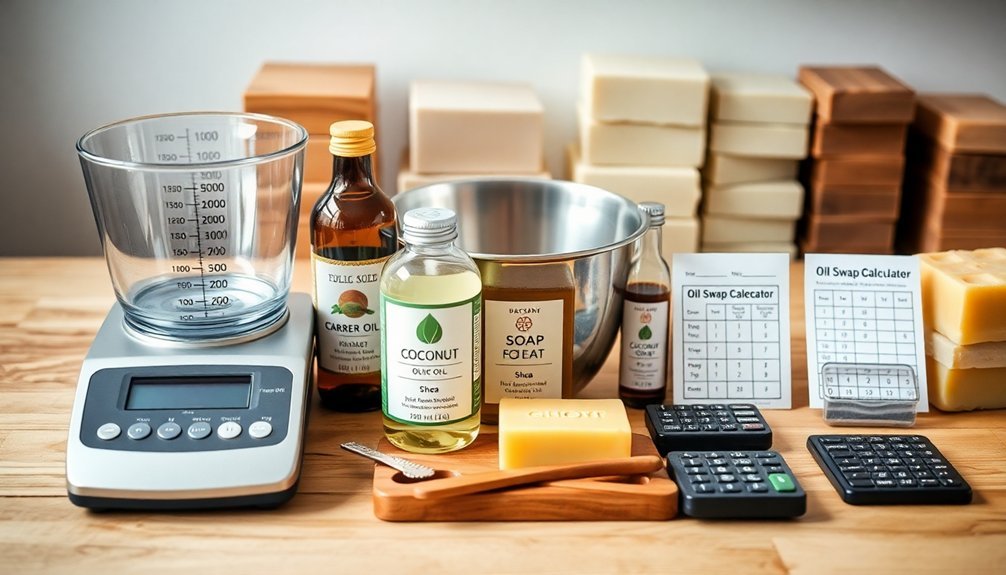
Precision stands at the heart of successful oil substitutions in soap making. You'll need reliable tools to guarantee your swapped formulations maintain the perfect lye ratio. A quality soap calculator becomes your most valuable asset when adjusting recipes with different oils.
To achieve professional results when swapping oils:
- Digital scale – Measure all ingredients by weight (grams/ounces), never volume, for accurate measurements that guarantee proper saponification.
- Soap calculator – Input your oil changes to automatically recalculate lye amounts based on different saponification values.
- Reference chart – Keep saponification values of common oils handy for quick comparisons.
- Testing notebook – Document all oil substitutions and results to track how changes affect your final bars.
Common Oil Substitutions and Their Effects
Armed with the right tools, you'll now need to know how specific oil swaps affect your soap's properties. When making oil substitutions, understanding the impact on your final product is essential for success.
Replacing palm oil with sunflower oil changes both hardness and lather, while substituting coconut oil with olive oil creates milder bars but reduces bubbliness. For enhanced lather and moisture, consider castor oil at 5-10% of your total oil weight.
Remember that different oils have unique saponification values, requiring you to recalculate your lye amount with each substitution. Without this adjustment, your soap may become too harsh or fail to properly set.
Every oil swap affects multiple soap properties simultaneously—hardness, conditioning, and cleansing ability—so test small batches before committing to large production runs.
Maintaining Hardness and Lather When Changing Oils
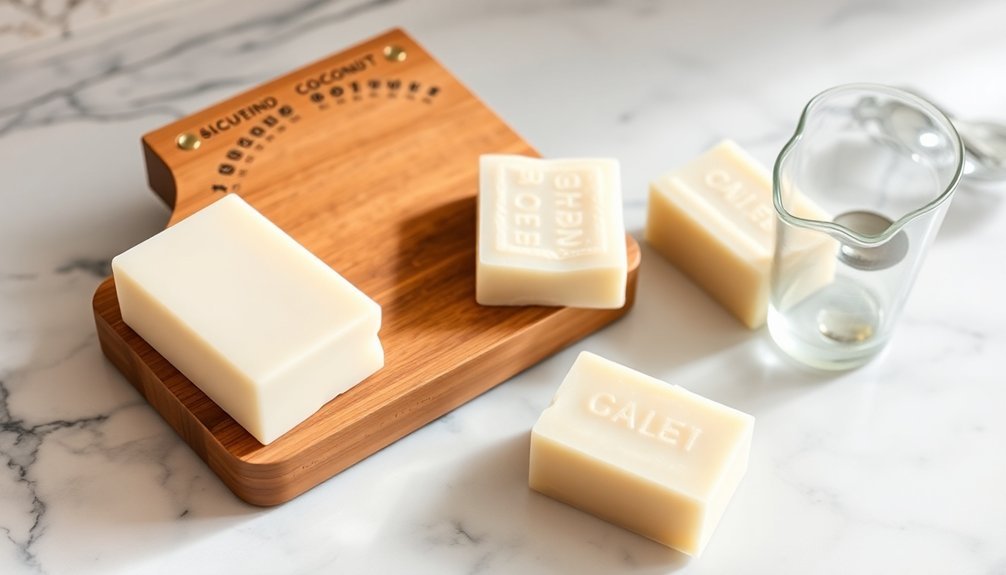
When you swap oils in your soap recipe, the hardness and lather qualities can shift dramatically if you're not careful. Each oil contributes unique properties, and knowing their saponification value is essential for calculating the correct lye amount.
To preserve your soap's quality when substituting oils:
- Match total oil weight exactly to your original recipe while recalculating lye needs.
- Balance hard oils like coconut and palm (20-30%) with softer oils to maintain proper hardness.
- Incorporate 5-10% castor oil to boost lather without compromising bar firmness.
- Limit high percentages of olive oil which creates moisturizing but potentially softer bars.
Adjusting Lye Amounts After Oil Substitutions
Changing your recipe's oils means you'll need to adjust your lye amounts accordingly. Different oils have unique saponification values, requiring specific lye quantities to transform into soap properly.
When making oil substitutions, always recalculate using a lye calculator. Simply input your new oil type and weight, and the calculator will determine the correct lye amount needed. For instance, swapping palm oil for sunflower oil will change your lye requirements due to their different fatty acid compositions.
Remember to verify that the total weight of oils remains consistent in your updated recipe before finalizing calculations.
Keeping a handy reference list of saponification values for your commonly used oils can make future substitutions faster and more accurate, ensuring your handmade bars turn out perfectly every time.
Troubleshooting Texture Issues in Reformulated Recipes
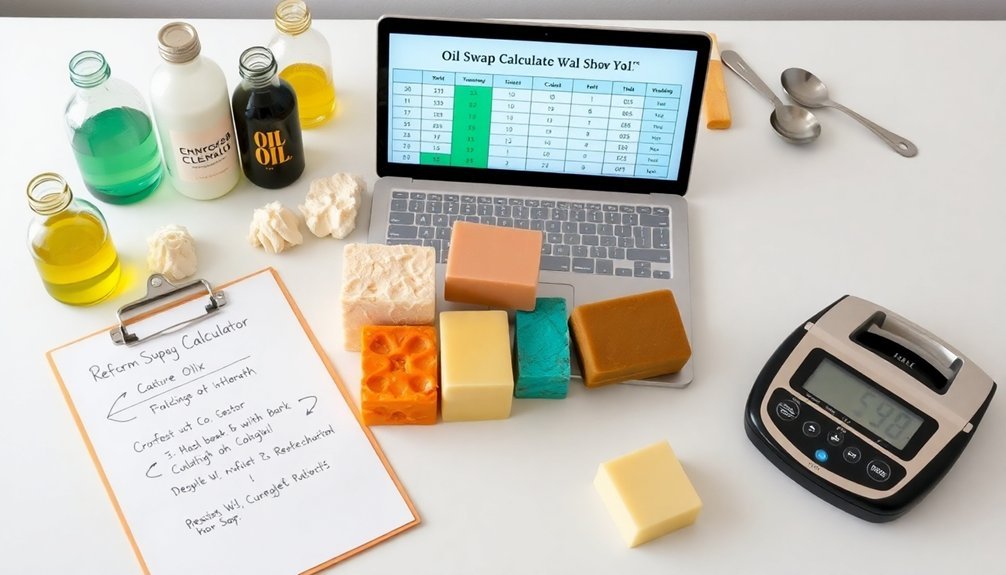
Despite careful calculations, texture problems can still emerge after reformulating your soap recipe with substituted oils. Maintaining consistent total oil weight is your first defense against unwanted texture changes.
Remember that different oils have unique saponification values that directly impact your final product.
When troubleshooting texture issues:
- Check your water-to-lye ratio first—aim for 1.5-2:1 to avoid bars that are either too soft (excessive water) or crumbly (insufficient water).
- Evaluate saturated fat content—high coconut oil percentages create firmness while linoleic oils produce softer bars.
- Recalculate lye amounts completely when swapping oils to verify proper saponification.
- Test small batches with additives like clay before scaling up, as they greatly alter texture.
Balancing Conditioning and Cleansing Properties
The science of successful oil substitution extends beyond texture to the functional properties of your soap. When swapping oils, you'll need to maintain a proper balance between conditioning and cleansing effects to create bars that clean effectively without drying the skin.
Aim for 30-50% conditioning oils like olive or avocado, which have lower saponification values (around 0.134), alongside 20-30% cleansing oils such as coconut or palm, with higher saponification values (approximately 0.183). This ratio creates well-rounded soap bars, but you can adjust based on skin type—increase conditioning oils for dry skin or cleansing oils for oily skin.
Don't forget about superfatting at 5-8%, which enhances moisturizing properties by leaving free oils in your finished bars, compensating for more cleansing-focused formulations.
Frequently Asked Questions
Can I Swap Animal Fats for Vegetable Oils Safely?
Yes, you can swap animal fats for vegetable oils in recipes, but you'll need to adjust ratios since they behave differently chemically. Research specific substitutions for your recipe to guarantee safety and proper consistency.
How Do Seasonal Temperature Changes Affect Oil Swap Calculations?
You'll need to adjust your oil swap calculations as temperatures change. Warmer seasons may require firmer oils to prevent melting, while colder months let you use softer oils without compromising bar stability.
Do Fragrance Oils Impact the Effectiveness of Oil Substitutions?
Yes, fragrance oils can impact your oil substitutions. They'll alter the final soap's properties and curing time. You'll need to adjust your swap calculations to account for the additional oil content they introduce.
Are Oil Swap Calculations Different for Hot Versus Cold Process?
No, your oil swap calculations remain the same for both hot and cold process. You'll use identical fatty acid profiles regardless of method, though the processing temperature doesn't change the substitution ratios you need.
Can I Use the Same Calculator for Liquid Soap and Shampoo Bars?
No, you'll need a different calculator for liquid soap and shampoo bars. They require different lye types (KOH vs NaOH) and formulation considerations than standard soap bars. Seek specialized calculators for these products.
In Summary
With your new understanding of oil swapping, you're now equipped to confidently modify any soap recipe. Remember to use your calculator, test small batches, and take notes on each modification. Don't be afraid to experiment—that's how you'll discover your signature formula. Your handmade bars will maintain perfect hardness, lather, and conditioning properties, even when you're working with substitute oils.

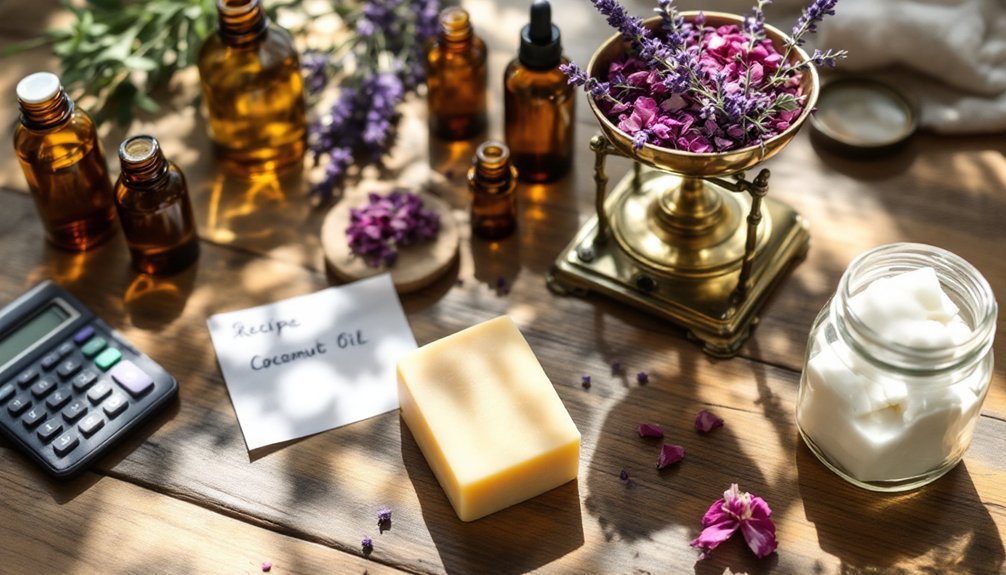



Leave a Reply